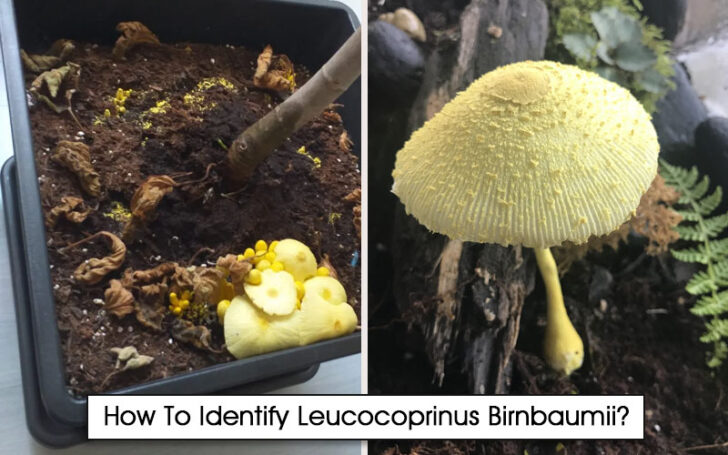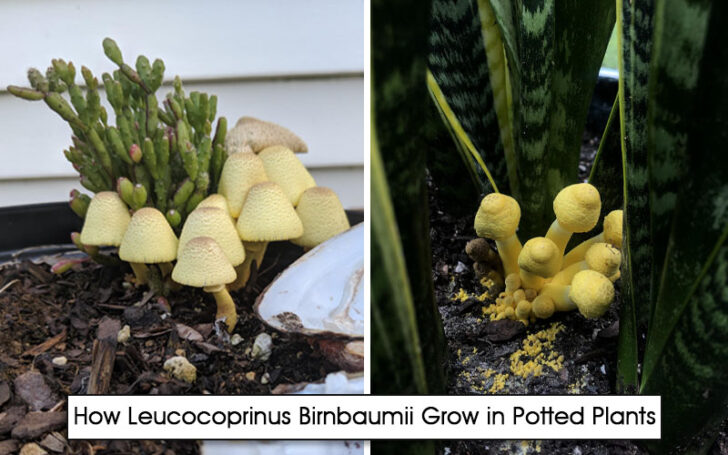Garden
Leucocoprinus Birnbaumii – Yellow Mushroom in Pots | Is It a Harmful Fungus?
Often weeds and fungi appear in such a way that we cannot decide whether they are detrimental or enhancing the beauty and health of the plant.
Not all beautiful mushrooms are poisonous; some are edible; but some can be toxic and destructive.
One of such harmful mushrooms we have is Leucocoprinus Birnbaumii or yellow mushroom.
It emerges spontaneously without notice in flower pots or gardens and begins to grow and extract nutrients from the original food plant.
The worst thing happens when such fungi attack a rare and expensive little plant on your plant.
Formerly known as Lepiota lutea, here is a detailed guide on Leucocoprinus Birnbaumii, commonly referred to as Plant Pot, detailing how to identify this fungus and how to get rid of it.
Check out this blog to get rid of weeds in your garden.
The Leucocoprinus Birnbaumii – Small Yellow Mushroom:
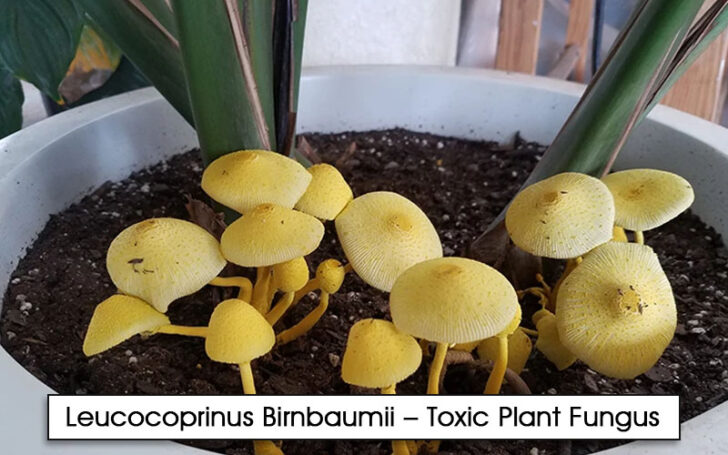
If you see small yellow shoots in your pot, it is Leucocoprinus Birnbaumii.
This cute mushroom is known by various names.
It has synonyms such as Yellow houseplant mushroom, Pot umbrella, Plant pot Dapperling, or yellow umbrella.
It is common for this type of fungus to appear in dark, wet places in greenhouses or pots during the summer and throughout the year.
● Yellow fungus:
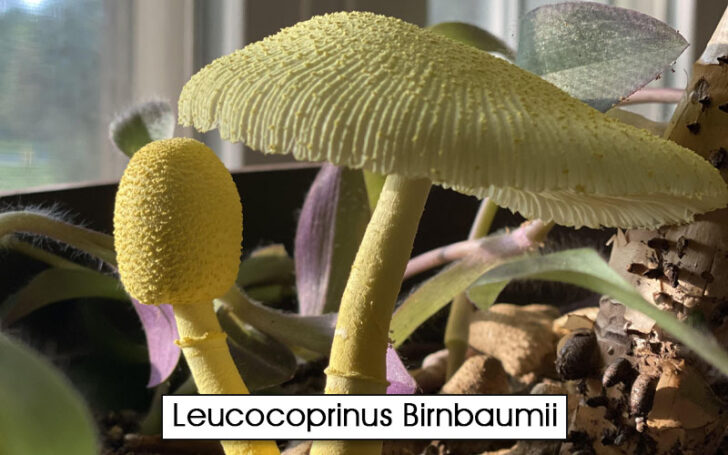
Here you should know that if it is yellow, it does not mean that it is Leucocoprinus Birnbaumii because there are several types of yellow mushrooms in botany.
The two most common types of yellow fungi are Aspergillus and Serpula lacrymans.
One is notorious for appearing due to water damage, the other is the fungus of wood mixed with Leucocoprinus Birnbaumii.
● Yellow Mushroom Identification:
How do you know if the yellow fungus on your houseplants is really Leucocoprinus Birnbaumii?
Well, use this formula:
While this fungus likes to grow near different healthy plants, other yellow mushrooms grow away from plants such as tree trunks or the soil of the sea, streams or any pond.
When you see a yellow head with your beautiful plant, in a pot or greenhouse where the soil is dense, moist and watery, call it Leucocoprinus Birnbaumii and try to find ways to get rid of this weed quickly.
If grown, it is not Leucocoprinus Birnbaumii or Plant pot Dapperling.
However, you will also have to know its physical characteristics:
Leucocoprinus Birnbaumii Physical Identification:
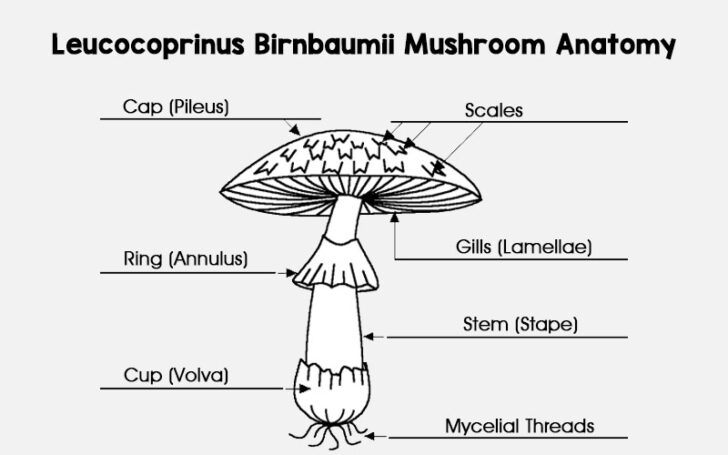
- Cover:
The cap is the top of your little yellow mushroom. It looks just like an umbrella and provides the same function, namely protection.
The cover protects the gills and seeds and cannot be seen without a microscope.
o Size:
From baby mushroom to maturity,
Leucocoprinus Birnbaumii can range in size from 2.5 to 5 centimeters.
o Color:
Of course, it looks yellow because it is called Yellow Fancy.
It has a bright yellow color as a baby, while the mature Dapperling is pale yellow, but its center is not brown.
The yellow Dapperling with a brown center is Leucocoprinus flavescens.
o Shape:
The nose shape is more oval (egg-like) when young.
When mature, the shape becomes generally conical, convex, or more like a bell.
o Texture:
There are fine scales on the texture of the cap.
A margin line appears in the middle until maturity.
2. Coverslip:
The lamella, also called mushroom gills, is a rib-like papery hymen under the mushroom nose.
It is not found in all fungi but can be seen in Leucocoprinus Birnbaumii.
The function of the lamellae is to help the parent fungus disperse the spores or seeds.
The lamellae of Leucocoprinus Birnbaumii are independent of the stem, have short but dense gills, and have repeating patterns.
They can have a bright yellow to pale yellow color.
3. Root:
To support the head, there is a ribbon-like structure called the trunk.
Cork sap is mostly used in kitchens because it is more often non-toxic.
However, this is not the case with this flower pot umbrella.
o Size:
The formula for determining the size of the handle:
Height x width.
This yellow houseplant mushroom is 3 – 10 cm long and 2–5 mm wide or thick.
From the base, the stem is even thicker, giving it a bloated feeling.
o Color:
It also has a color from pale yellow to whitish yellow.
o Texture:
The texture is the same as the cover; dry and dusty.
However, they do not have spores or gills; bald.
You may also see a fragile yellow ring appearing and disappearing on it.
4. Trama:
It is also called Trama meat because of the fleshy part inside the mushroom fruit body.
Here’s what you need to know about yellow mushroom meat.
Birnbaumii has white and very liquid flesh that is poisonous to humans and animals, but not to the plant itself, just like Galerina marginata.
5. Odor:
It has the sickening odor of most fungi, such as dead organic plants or rotting leaves.
You could say they smell like a lush forest after a rain, like a corpse.
Yellow Mushroom in Pots – How Harmful it is:
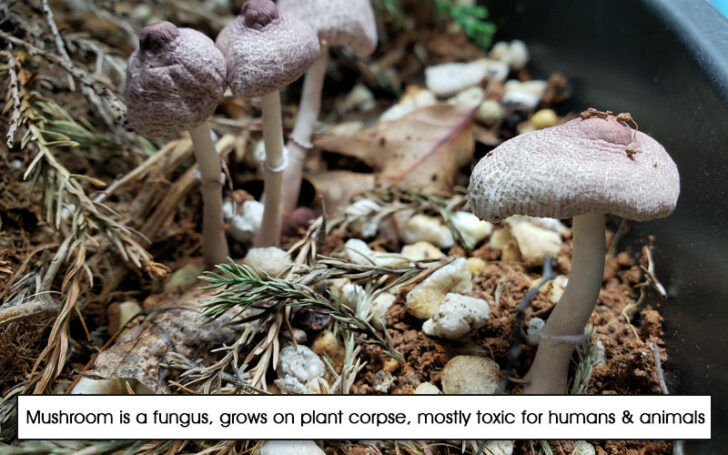
Let’s know if it is harmful, edible, poisonous and what kind of harm or benefit it can bring to your plant.
Some information about mushrooms:
First of all, although mushrooms grow like plants in pots on tree trunks, near ponds, they are still fungi, not plants or animals.
Fungi have their own kingdom, unlike plants and animals.
You can see them growing on dead plants.
This does not mean that if you see a yellow pod in a pot and your plant is really dead.
How Leucocoprinus Birnbaumii Grow in Potted Plants?
Birnbaumii breeds on dead plants but only on dead plants. Seeing these in pots does not mean that your plant is dead.
You use several types of organic material as fertilizer to grow your plant.
While the ingredients are organic, there may also be some dead organic parts that are the reason this fungus sprouts.
Remember, even if it is not considered harmful to living plants, it is still necessary to get rid of these poisonous mushrooms.
These are harmful to humans and therefore should not be near beautiful edible plants.
By growing side by side, toxicity may or may not be transferred.
It is necessary to get rid of this fungus.
How to Get Rid of Yellow Fungus in Soil?
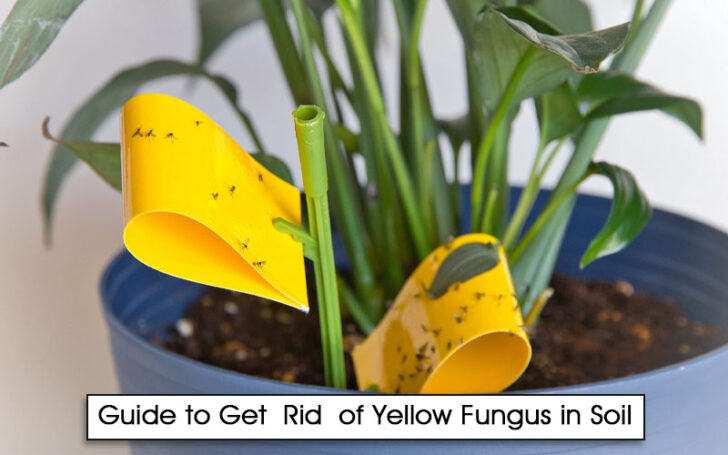
Here are the steps to follow to get rid of the Leucocoprinus Birnbaumii fungus:
1. Change plant / Pot location:
All types of mushrooms, including this Birnbaumii, love dark, wet places to grow.
Therefore, the first thing to stop their feeding is to relocate the pot or plant to one that is lighter and has less air flow.
In some cases, the fungi die there.
However, if you have an entire nursery or plants that need air and shade to grow, this step alone won’t help.
Don’t worry, here are a few more tips:
2. Remove the yellow fungus:
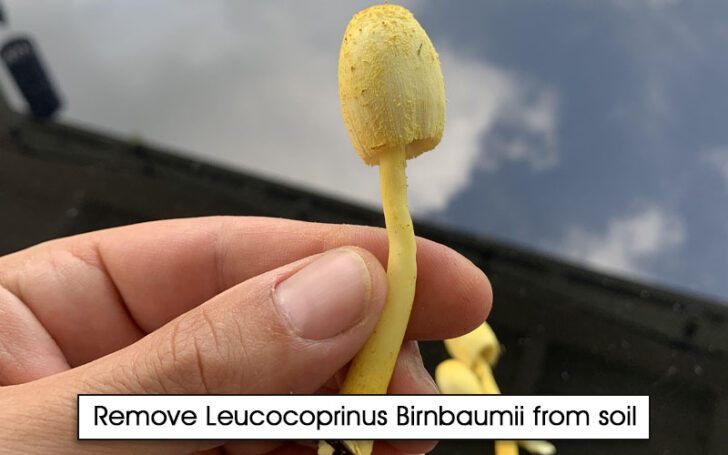
It is necessary to remove the cork. For this, try to unroot the plant using any tool that reaches the bottom and separate the Birnbaumii from the ends.
Try using a tool like a standing plant root remover to avoid damaging the roots of your original flower.
3. Use Baking Soda & Water Mixed Spray:
You can also use a homemade spray.
To make it
Gather ingredients such as 1 tablespoon of baking soda and a gallon of clean fresh water.
Tip: If the fungus is stubborn, increase the amount of baking soda.
Mix both and store in a spray bottle.
Now spray from time to time until you see that the fungus is no longer growing.
For a larger area such as a greenhouse or nursery, use spray guns to completely cover the area.
4. Sprinkling the cinnamon:
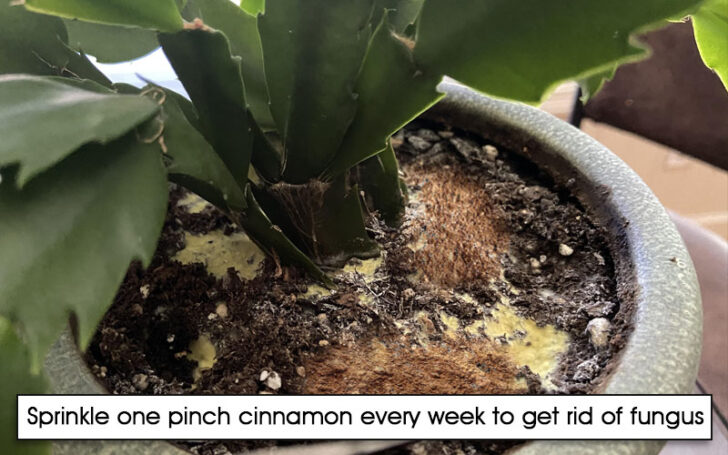
There are many types of herbs that replace the therapeutic and germ-free effects of expensive drugs.
One such plant is cinnamon.
You can sprinkle a pinch of cinnamon on the pots every week until the fungal symptoms subside.
Be sure to keep up with the low amount or affect the root of the original plant.
5. Molding the soil:
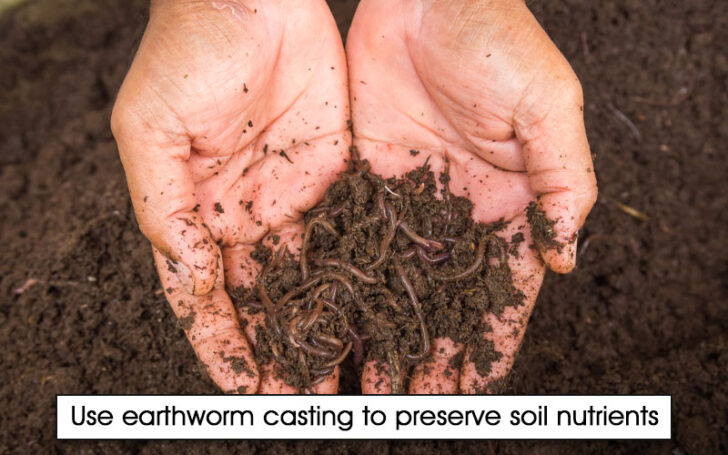
Revitalize the fertility of the soil. Use worm dump for this.
Try to apply a 1-inch layer over the soil.
Finally, if you still see the growth of Leucocoprinus Birnbaumii is there, using chemicals or getting out of the pot remains the only solution.
Now repot your plant.
Chemical sprays work well if you see the fungus in the entire nursery or in a large area.
With all this, you need to be wary of similar types of houseplant mushrooms.
What Are Houseplant Fungi Similar to Leucocoprinus Birnbaumii?
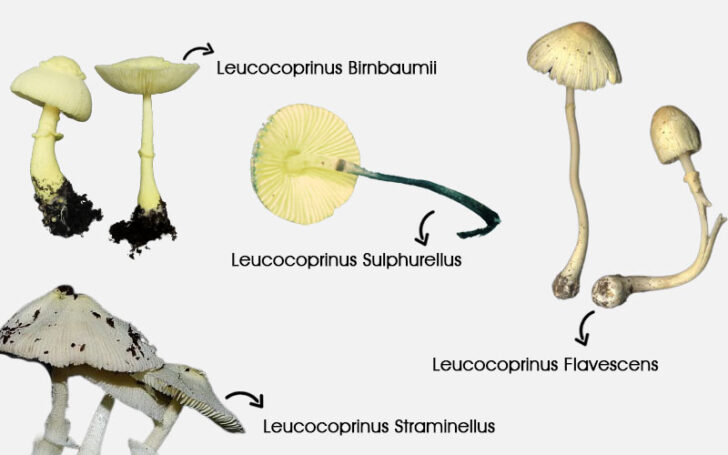
Remember, houseplants can not only be attacked by yellow Dapperling, but there are many more species.
Here are some species similar to Birnbaumii:
- Leucocoprinus straminellus (has a slightly pale or white fungus) is famous for its occurrence in temperate regions.
- Leucocoprinus flavescens (yellow cap with a brown center) is famous for appearing in houseplant pots in North America.
- Leucocoprinus sulphurellus (yellow mushroom with blue-green gills) is famous in tropical regions such as the Caribbean Sea.
Bottom Line:
It’s all about plants and their health and how you can easily get rid of these fungi on your plants.
We hope you enjoyed this guide. Please write to us for any questions.
Also don’t forget to check how to get rid of weeds because that’s another problem for us gardeners.
Also, don’t forget to pin/bookmark and visit our blog for more interesting but original information.
